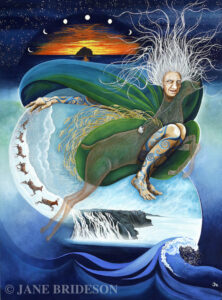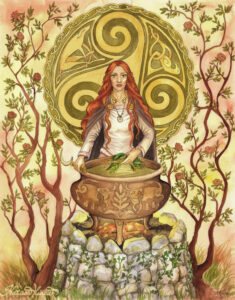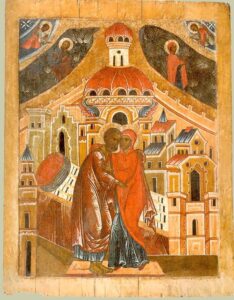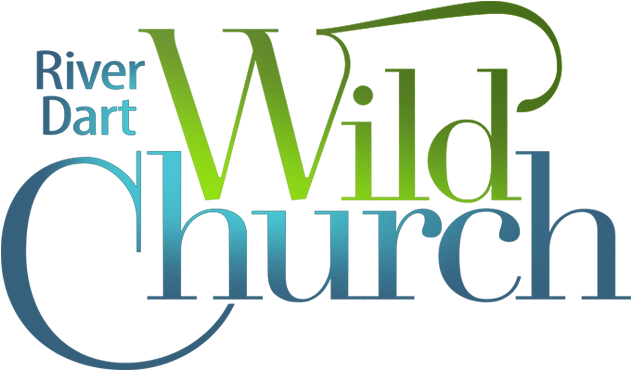The Twelve Days of Christmastide, including New Year 2021 saw the UK move back into lockdown, which was not at all the new beginning that many of us had been hoping for, but it seemed a necessary response to the ongoing challenges of the global covid pandemic. Like many people, I was not able to see most of my family over the holy days, including my beloved mother. So it seemed more important than ever that our Wild Church/Monastics continued to offer online gatherings for those who wanted them. What a blessing it has been for me personally that both my Mum, Anne, and my younger son, Tam, have therefore actually been able to join River Dart Wild Church, along with friends both old and new from around the world. A new kind of wild church is being shared as we hear about the land, seasons and weather from members in different places, communities and time zones!
River Dart Wild Church has almost always met outside and through walking together in contemplative pilgrimage. So I gave much thought to how some of the spirit of this could continue in our ‘Zooming Wild Church’ gatherings. What came to me was to hold our core communion structure of ‘gather, engage, share, bless‘ and adapt to an online form, starting by sending out an invitation for all who wished to bring a wild/natural token to share. So now we gathered on Zoom, opening our Zoom church community 15 mins before the ‘service’ began, so there was time to say hello and welcome newcomers (which in our wild church is many of us, in our continually emerging and changing group constellation). In both conversation and through using the Zoom ‘chat’ function, we could share names & where we were from. Our ‘gathering‘ then continued with a short silence, followed by the invitation to share our wild token, both visually and in a few words either spoken or by ‘chat’. It was fascinating to see the different ways people responded to this, with some bringing examples of plants met in their local countryside, farm or garden, while others brought house plants, nature findings such as feathers or special treasures crafted from natural materials.
 The pilgrimage aspect was now represented by a story that featured some kind of ‘journey’ or narrative arc, accompanied by imagery/iconography and sometimes music. The storytelling was also the ‘engage‘ part of our communion, where previously we would have been engaging with the book of nature through silent walking. Over the months, before we felt able to meet again in person in mid April, I told three of my favourite stories, each of which I re-crafted to emphasise a female perspective. For the first Sunday of February, so not far from the festivals of Imbolc and Candlemas, it was the tale of Bride (as the spring maiden) and the Cailleach (the old wise woman of winter). This was my own retelling inspired by a tale created by Caitlin Matthews (The Cailleach of the Snows in Celtic Memories, published by Barefoot Books), herself drawing on Scots Gaelic sources. I love the sense it gives, of the cyclic nature of the dance of the seasons, both outer and inner, with the helpful reminder that tough times will be followed by gentler ones and yet changes continue to unfold and wisdom can be found in every season. I drew on art both old and new, with a beautiful contemporary image of the Cailleach (shown left) by Jane Brideson and the equally inspiring painting of Saint Bride created by the Scottish artist John Duncan, which I regularly visited in the National Gallery in Edinburgh during my years living in the Highlands. Musical inspiration came from the oyster catcher, who features as a guide to Brigid in the story and from the Dance of the Mill Dust, which Bride and the Cailleach dance together during the story, symbolising the dance of the seasons from winter to spring (and back again… and again).
The pilgrimage aspect was now represented by a story that featured some kind of ‘journey’ or narrative arc, accompanied by imagery/iconography and sometimes music. The storytelling was also the ‘engage‘ part of our communion, where previously we would have been engaging with the book of nature through silent walking. Over the months, before we felt able to meet again in person in mid April, I told three of my favourite stories, each of which I re-crafted to emphasise a female perspective. For the first Sunday of February, so not far from the festivals of Imbolc and Candlemas, it was the tale of Bride (as the spring maiden) and the Cailleach (the old wise woman of winter). This was my own retelling inspired by a tale created by Caitlin Matthews (The Cailleach of the Snows in Celtic Memories, published by Barefoot Books), herself drawing on Scots Gaelic sources. I love the sense it gives, of the cyclic nature of the dance of the seasons, both outer and inner, with the helpful reminder that tough times will be followed by gentler ones and yet changes continue to unfold and wisdom can be found in every season. I drew on art both old and new, with a beautiful contemporary image of the Cailleach (shown left) by Jane Brideson and the equally inspiring painting of Saint Bride created by the Scottish artist John Duncan, which I regularly visited in the National Gallery in Edinburgh during my years living in the Highlands. Musical inspiration came from the oyster catcher, who features as a guide to Brigid in the story and from the Dance of the Mill Dust, which Bride and the Cailleach dance together during the story, symbolising the dance of the seasons from winter to spring (and back again… and again).
 On the first Sunday of March the storytelling moved from Scotland to my motherland of Wales, with the story of Ceridwen and Taliesin. For this I drew inspiration from Lady Charlotte Guest’s translation of the Mabinogion, from a beautiful edition given to me by my parents and featuring illustrations by Alan Lee. Of course, my creative re-telling of the story features the wise woman/Goddess Ceridwen much more than the traditional version of the tale, usually just called ‘Taliesin’. In this I have been much inspired by three decades as a Bard within the Order of Bards, Ovates and Druids. For me it is the divine source, symbolised here by Ceridwen, who is the real power in the story, as she drives the rather unconscious spiritual seeker (Taliesin) through a series of elemental transformations and shapeshifting that lead to a spiritual realisation and rebirth, culminating in a process of creative empowerment and then initiation and entry into a life of service as a Bard. Sadly Alan Lee’s illustrations don’t include one of Ceridwen, but I love the one shown here (right), created by Nataša Ilinčić.
On the first Sunday of March the storytelling moved from Scotland to my motherland of Wales, with the story of Ceridwen and Taliesin. For this I drew inspiration from Lady Charlotte Guest’s translation of the Mabinogion, from a beautiful edition given to me by my parents and featuring illustrations by Alan Lee. Of course, my creative re-telling of the story features the wise woman/Goddess Ceridwen much more than the traditional version of the tale, usually just called ‘Taliesin’. In this I have been much inspired by three decades as a Bard within the Order of Bards, Ovates and Druids. For me it is the divine source, symbolised here by Ceridwen, who is the real power in the story, as she drives the rather unconscious spiritual seeker (Taliesin) through a series of elemental transformations and shapeshifting that lead to a spiritual realisation and rebirth, culminating in a process of creative empowerment and then initiation and entry into a life of service as a Bard. Sadly Alan Lee’s illustrations don’t include one of Ceridwen, but I love the one shown here (right), created by Nataša Ilinčić.
 For our final ‘Zooming Wild Church’ on the first Sunday of April, and as it was Easter Sunday, it was my ‘herstory’ version of the Easter story that I told, featuring the women of the Christian story and moving from the conception of Mary to her assumption. How different this familiar (to some) story sounds when the parallel stories of Mary and Jesus are told together. Mary’s story becomes our own, for those who seek to embody the light and love of Christ in their way of living and the story of Jesus, like that of the Cailleach and of Ceridwen, shows the profound and paradoxical generous/challenging and embodied/transcendent nature of divine love. For this storytelling I took us through a gallery of traditional iconographic images, from the (modestly and symbolically portrayed and yet no less) ecstatic meeting and love making of Mary’s parents at her conception (as shown left) to the equally ecstatic moment of the mature Mary being lifted up into divine union with God in Christ.
For our final ‘Zooming Wild Church’ on the first Sunday of April, and as it was Easter Sunday, it was my ‘herstory’ version of the Easter story that I told, featuring the women of the Christian story and moving from the conception of Mary to her assumption. How different this familiar (to some) story sounds when the parallel stories of Mary and Jesus are told together. Mary’s story becomes our own, for those who seek to embody the light and love of Christ in their way of living and the story of Jesus, like that of the Cailleach and of Ceridwen, shows the profound and paradoxical generous/challenging and embodied/transcendent nature of divine love. For this storytelling I took us through a gallery of traditional iconographic images, from the (modestly and symbolically portrayed and yet no less) ecstatic meeting and love making of Mary’s parents at her conception (as shown left) to the equally ecstatic moment of the mature Mary being lifted up into divine union with God in Christ.
To complete our fold fold communion pattern, after we had gathered through sharing our natural tokens and then engaged with the journey of the story, we had time to share how this had touched, stirred, annoyed or inspired us. We then closed our time of ‘Zooming Wild Church’ with a final time of quiet, contemplative prayer to remember loved ones and to send out blessings towards sufferings in the wider world. Judging from the many messages I received, I was not the only one who then went back into my life and the month to come, feeling blessed, nourished, encouraged and inspired by all that we had shared and received together.
